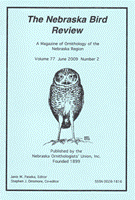Nebraska Ornithologists' Union

Nebraska Bird Review
Date of this Version
12-2014
Document Type
Article
Citation
Silcock, "Fall Field Report, August–November 2014," from Nebraska Bird Review (December 2014) 82(4).
Abstract
My first paragraph from last year's fall report read as follows: "In most ways, this was a routine fall season. Most interesting from an ongoing point of view were quite a large number of sightings of passerines at rather late dates, notably among Empidonax flycatchers, wood warblers, native sparrows, tanagers, towhees, grosbeaks, and buntings." This fall was no different; the trend seems to be that final sighting dates for many species are pushing against their latest expected dates.
There were several tidbits of interest, more or less unrelated, but perhaps most notable takeaways for the season were the number of species that had rare records either east or west of their usual ranges and the several state-level rarities. As with last year, there were some excellent record or near-record high counts for a few species.
The aforementioned "tidbits" follow. Evidence is accumulating that Mute Swans may soon land on the NOU Official State List; occurrences that fit wild provenance are discussed in the species account. Redheads bred in the Rainwater Basin for only the 4th time. There is discussion of a very strange Pectoral Sandpiper (Sandpipers?) in Dakota County that no doubt will be a source of puzzlement for some observers. Late broods included 3 record late groups of nestling Barn Owls taken to Fontenelle Forest Raptor Recovery 15 Oct–6 Nov, and an Eastern Wood-Pewee brood 13 Sep. Pine Siskins were nowhere in the state until September, not even in their usual Panhandle pinewoods habitats.
Rare records east or west of usual ranges included Yellow-rumped (Audubon's) Warbler, Yellow-breasted Chat, Field Sparrow, and Rusty Blackbird. Counts of note included 400 Forster's Terns, two large flocks of Warbling and Red-eyed Vireos (117 and 79), 80 Pinyon Jays, 22 Sage Thrashers reported in all, and 300 Great-tailed Grackles. Three erratic winter species appeared, but only 1–2 of each: Mountain Chickadee, Bohemian Waxwing, and Evening Grosbeak, all in the west.
Of the rarities, most exciting was the presence of male and female American Three-toed Woodpeckers in East Ash Canyon, Dawes County, discovered by Rocky Mountain Bird Observatory surveyors and re-found by several Nebraska observers; these are the 3rd and 4th for Nebraska. It is unknown if they are a pair; they were not seen together. The 6th state record Black-throated Sparrow appeared in Virginia Clark's yard, which is becoming a rare bird magnet, with photos to back up its claim. Rare jaegers and gulls showed well: there were 2 separate Long-tailed Jaegers, 9th and 10th for the state, the 19th state Little Gull, and the 22nd state Laughing Gull. Perhaps as rare as any of these was a White-rumped Sandpiper, a species not supposed to be in the interior in fall.


Comments
Copyright 2014 Nebraska Ornithologists’ Union. Used by permission.